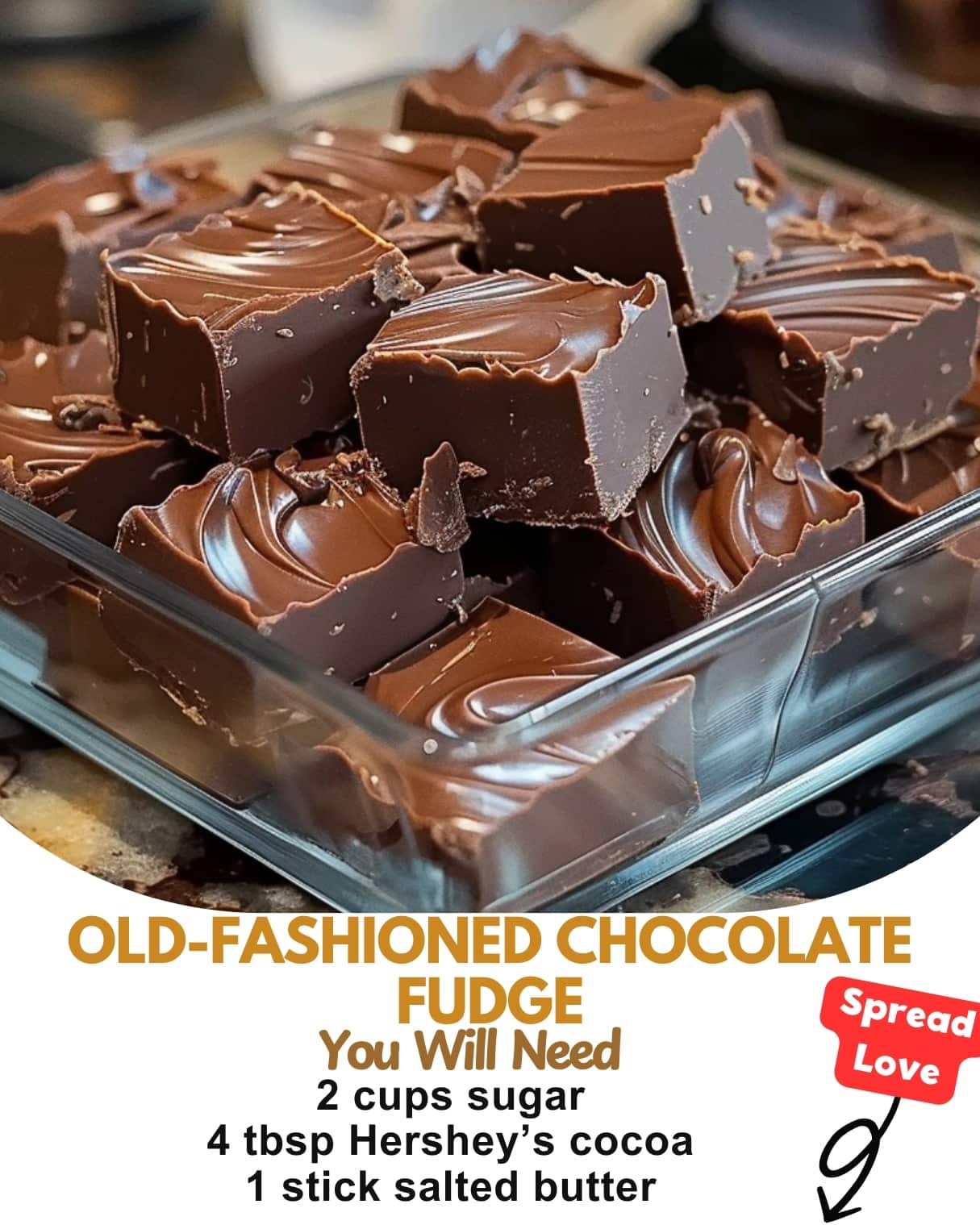This Old-Fashioned Chocolate Fudge recipe creates a rich, creamy confection with perfect texture through traditional candy-making techniques. Unlike quick modern versions, this authentic recipe requires careful temperature monitoring and proper beating to achieve the ideal crystallization. The result is a deeply satisfying chocolate treat with that distinctive fudge texture that chocolate lovers crave. Each batch makes approximately 36-64 pieces depending on how you cut them.
Old-Fashioned Chocolate Fudge: A Timeless Sweet Tradition
There’s something magical about the rich, velvety texture of properly made old-fashioned chocolate fudge that simply cannot be replicated by modern shortcuts. This recipe stands as a testament to confectionery traditions that have delighted generations. Unlike quick-set or microwave fudge varieties, true old-fashioned chocolate fudge requires patience, precision, and a touch of finesse—but the results are incomparably superior.
The beauty of this old-fashioned recipe lies in its transformation process. What begins as a simple mixture of sugar, chocolate, and dairy undergoes a remarkable metamorphosis through careful temperature control and proper crystallization. The result is a confection with the perfect balance between creamy smoothness and that distinctive fudge texture that melts slowly on your tongue, releasing deep chocolate notes with each bite.
Why You Should Try This Recipe
This recipe connects us to a simpler time when candy-making was both an art and a science practiced in home kitchens. Before mass-produced confections lined store shelves, fudge was a special treat reserved for holidays and celebrations. Making it was often a family affair—children would gather around to watch the magical moment when the molten mixture was beaten into a satiny mass that would set into perfect squares of deliciousness.
Beyond nostalgia, this old-fashioned chocolate fudge offers flavor complexity that modern versions simply can’t match. The controlled crystallization creates microscopic sugar crystals that give authentic fudge its characteristic mouthfeel—neither too grainy nor too soft. The slow cooling and beating process allows the chocolate flavor to develop fully and meld beautifully with the dairy components.
When you present a plate of this homemade fudge, you’re offering more than just a sweet treat; you’re sharing a piece of culinary heritage. In our fast-paced world of instant gratification, taking the time to master this traditional cooking technique provides a deeply satisfying experience—one that rewards both the maker and those fortunate enough to enjoy the finished product. The compliments you’ll receive will confirm that some traditions are worth preserving exactly as they’ve been passed down through generations.
Storage Options
- Room Temperature: Store in an airtight container with waxed paper between layers for up to 1 week. Keep in a cool, dry place away from direct sunlight.
- Refrigerator: For longer freshness, refrigerate in an airtight container for up to 2-3 weeks. Allow to come to room temperature before serving for best flavor and texture.
- Freezer: Wrap tightly in plastic wrap, then aluminum foil, and place in a freezer bag. Freeze for up to 3 months. Thaw in the refrigerator overnight, then bring to room temperature before serving.
- Gift Packaging: For gifting, wrap individual pieces in waxed paper or place in mini paper cups within decorative tins or boxes. Will stay fresh for about 1 week.
Summary
Equipment
- Heavy-bottomed 3-4 quart saucepan
- Candy thermometer
- Wooden spoon
- 8-inch square baking pan
- Parchment paper or aluminum foil
- Measuring cups and spoons
- Heatproof spatula or butter knife
- Sharp knife for cutting
Ingredients
- 3 cups granulated sugar
- 3/4 cup unsalted butter
- 2/3 cup evaporated milk
- 12 oz high-quality semisweet chocolate, chopped (or chocolate chips)
- 1 jar (7 oz) marshmallow creme
- 1 teaspoon pure vanilla extract
- 1 cup chopped walnuts or pecans (optional)
- 1/4 teaspoon salt
Instructions
- Line an 8-inch square baking pan with parchment paper or aluminum foil, leaving overhang on the sides for easy removal. Lightly butter the lining.
- In a heavy-bottomed saucepan, combine sugar, butter, evaporated milk, and salt. Bring to a full rolling boil over medium heat, stirring constantly with a wooden spoon to prevent scorching.
- Once boiling, attach a candy thermometer to the side of the pan, making sure it doesn’t touch the bottom. Continue to boil, stirring constantly, until the mixture reaches 234°F (soft-ball stage), about 4-5 minutes.
- Remove from heat immediately and add the chopped chocolate and marshmallow creme. Stir vigorously until chocolate is completely melted and mixture is smooth.
- Add vanilla extract and nuts (if using) and stir to incorporate.
- Working quickly, pour the fudge into the prepared pan. Use a spatula to spread it evenly into the corners.
- Allow the fudge to cool at room temperature for at least 2-3 hours, or until completely set.
- Once set, lift the fudge out of the pan using the parchment paper overhang. Place on a cutting board and cut into 1-inch squares with a sharp knife.
- Store in an airtight container with waxed paper between layers.
Notes
- This recipe uses the “soft-ball stage” method of candy making, which is crucial for achieving the proper fudge texture.
- For best results, make fudge on a day with low humidity, as excess moisture in the air can affect how the candy sets.
- The quality of chocolate significantly impacts the final flavor. Use the best chocolate you can afford for superior results.
- Do not substitute sweetened condensed milk for evaporated milk—they are different products with different properties.
Tips for Success
- Use a heavy-bottomed saucepan to prevent hot spots that could cause the sugar to burn.
- Don’t rush the boiling process—maintain a steady temperature and stir continuously.
- Have all ingredients measured and ready before you start (mise en place), as timing is critical once the mixture reaches temperature.
- For perfect texture, avoid stirring the fudge while it’s cooling in the pan.
- If your fudge turns out too soft, it likely didn’t reach the proper temperature. If too hard or grainy, it may have been overcooked or over-beaten.
- A clean, dry candy thermometer is essential for accuracy—even a few degrees can make a difference in the final texture.
- Allow the fudge to cool completely before cutting to ensure clean edges.
Additional Tips and Variations
- Dark Chocolate Variation: Substitute dark chocolate (70% cocoa) for a more intense, less sweet fudge.
- Mocha Fudge: Add 1-2 tablespoons of instant espresso powder when adding the vanilla.
- Mint Chocolate: Replace vanilla extract with 1 teaspoon of peppermint extract.
- Rocky Road: Fold in 1 cup of mini marshmallows along with the nuts.
- Layered Fudge: Make a half batch of this recipe and a half batch of white chocolate or peanut butter fudge. Pour the first layer, let it set partially, then add the second layer.
- Bourbon Fudge: Add 1-2 tablespoons of quality bourbon with the vanilla for an adult treat.
- Orange Chocolate: Add 2 teaspoons of orange zest and 1/2 teaspoon of orange extract when adding the vanilla.
- Texture Enhancement: For extra texture contrast, sprinkle the top with flaky sea salt or crushed candy canes before the fudge sets.
Frequently Asked Questions (FAQ)
Q: Why did my fudge turn out grainy? A: Graininess usually results from sugar crystals that formed too large. This can happen if the mixture was stirred during cooling or if sugar crystals remained on the side of the pan during cooking. To prevent this, brush down the sides of the pan with a wet pastry brush during cooking and avoid disturbing the fudge while it sets.
Q: Can I make this recipe without a candy thermometer? A: While a thermometer provides the most reliable results, you can use the cold water test. Drop a small amount of the mixture into cold water. If it forms a soft, malleable ball that flattens when removed from the water, it’s reached soft-ball stage (234°F-240°F).
Q: Why did my fudge not set properly? A: Fudge that doesn’t set usually hasn’t reached the correct temperature. Be sure your thermometer is calibrated correctly and that the mixture reaches 234°F.
Q: Can I double this recipe? A: Yes, but use a larger pot and pan. Keep in mind that larger batches may take longer to reach temperature and require more beating to achieve the proper crystallization.
Q: Is it necessary to use marshmallow creme? A: For truly old-fashioned fudge, you can omit it, but you’ll need to beat the mixture more vigorously as it cools to achieve proper crystallization. The marshmallow creme helps stabilize the fudge and make it more foolproof.
Q: Can I use milk chocolate instead of semisweet? A: Yes, but the fudge will be sweeter and have a milder chocolate flavor. You might want to reduce the sugar slightly, but this will affect the texture.
Conclusion
Making Old-Fashioned Chocolate Fudge is more than just creating a sweet treat—it’s participating in a time-honored culinary tradition that connects generations. The process requires attention and patience, but the reward is incomparable to quick-method alternatives. Each piece of this velvety, rich chocolate confection offers a texture and flavor profile that speaks to the care taken in its preparation.
What makes this recipe special is the balance it strikes between accessibility and authenticity. While it requires some technique, the instructions guide you through each critical step to ensure success. Once mastered, this fudge recipe becomes a treasured addition to your repertoire of homemade gifts and holiday traditions.
There’s something deeply satisfying about watching simple ingredients transform through your efforts into something so sublime. As you share this fudge with friends and family, you’re not just offering them a sweet—you’re giving them a taste of confectionery perfection that has stood the test of time. In a world of mass-produced sweets, this homemade chocolate fudge stands as a reminder that some pleasures are worth the extra time and effort they require.

